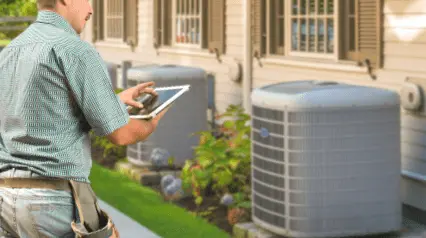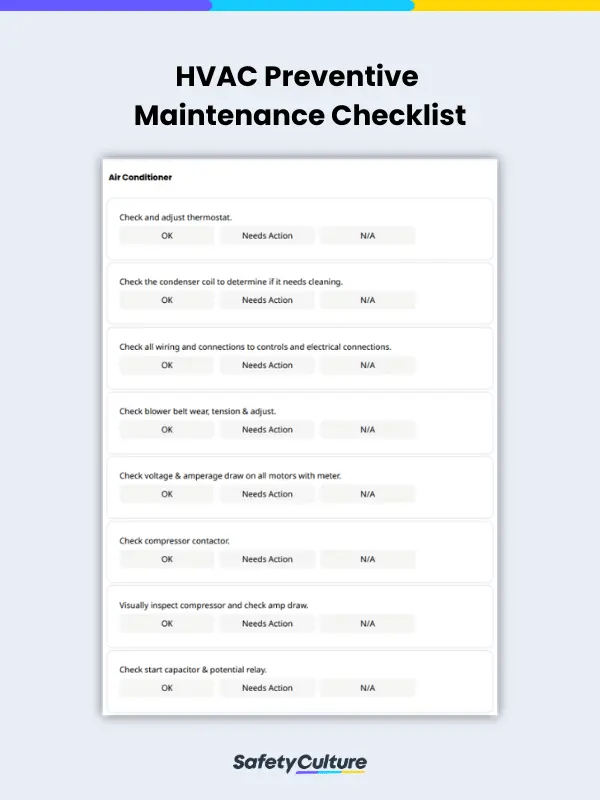HVAC maintenance is the periodic inspection of either commercial or residential heating, ventilation, and air conditioning systems. Performing regular HVAC maintenance can prolong equipment life, reduce repair incidence, and prevent costly breakdowns. HVAC contractors and property managers should perform HVAC preventive maintenance inspections at least quarterly or bi-annually, especially before peak usage seasons. Though the exact maintenance requirements of each property and unit are different, in general, HVAC maintenance involves cleaning, removing debris, replacing filters, and testing the functions of various components. To maintain HVAC systems, contractors also check for leaks and signs of corrosion. Such issues may indicate that there is a larger, more systemic problem which needs to be addressed sooner rather than later.
What is an HVAC Maintenance Checklist?
An HVAC maintenance checklist is used to easily conduct preventive maintenance of an HVAC system in commercial buildings and residential properties. Utilizing digital HVAC checklists help easily identify signs of HVAC failure, address potential issues, and ensure that heating, ventilation, and air conditioning systems are well-maintained and running cost-efficiently.
What Equipment is Checked During HVAC Maintenance?
The following equipment is checked during routine HVAC maintenance:
- Air Conditioner
- Heat Pump
- Electric Heater
- Gas Furnace
- Dual Fuel Heat Pump Furnace
HVAC Maintenance Steps
When doing HVAC preventive maintenance, also take note of the following steps to observe HVAC systems’ good working condition:
- Check HVAC equipment individually – Use checklists or templates that list down all the items that needed detailed checking when doing HVAC maintenance. Check air conditioner, heat pumps, electric heater, gas furnace, and dual fuel heat pump furnace, then specify actions for areas that need modification or improvement.
- Change filters regularly – As excessive as it may sound, it is ideal to perform regular HVAC tune ups and change filters every 30-90 days to keep them from being dirty. Clean filters improve HVAC performance and help ensure the unit’s efficiency. In turn, this regular filter change can help reduce monthly energy bills.
- Clean HVAC surroundings – Keep the area around the unit clear of leaves, grasses, dirt, or other forms of debris. Aside from that, remove clogs of mold or algae that developed inside the conditioners. This is to make sure that these little items don’t build up and cause the system to perform poorly.
- Examine refrigerant lines consistently – Check refrigerant lines at least once a month to confirm that they aren’t torn, lose, detached, or leaking. Regularly performing this step helps ensure that the desired temperature for cooling or heating a place of business, home, or other property is always maintained.
- Note unusual odors and noises – Always watch out for unusual odors or noises that occur whenever a unit is turned on. When happening normally, this can indicate the presence of other severe problems so recognizing and addressing them early helps prevent further damage to the unit.
- Inspect fan blades – Observe fan blades every couple of months to identify if there are significant signs of dirt, damage, or wear and determine if there’s immediate action needed. Otherwise, you can share these observations with HVAC technicians during scheduled maintenance inspections.
- Replace batteries as needed – When changing the batteries for smoke alarms, it is also ideal to simultaneously change the batteries of carbon monoxide detectors of the HVAC systems. Doing this regularly helps ensure that the detectors are always in safe and proper working condition.
What are HVAC Inspection Report Forms?
An HVAC inspection report details all the issues found during preventive maintenance and follow-up actions necessary for maintaining HVAC efficiency. Key HVAC inspection report findings may also include a comprehensive cost estimate for any repair or replacement work to be performed.
HVAC inspection report forms typically cover the following key areas of HVAC equipment:
- Equipment wear and tear
- Parts to be cleaned, replaced, or lubricated
- Motors and controls
- Condition of electrical connections and voltage
- Coil temperature


